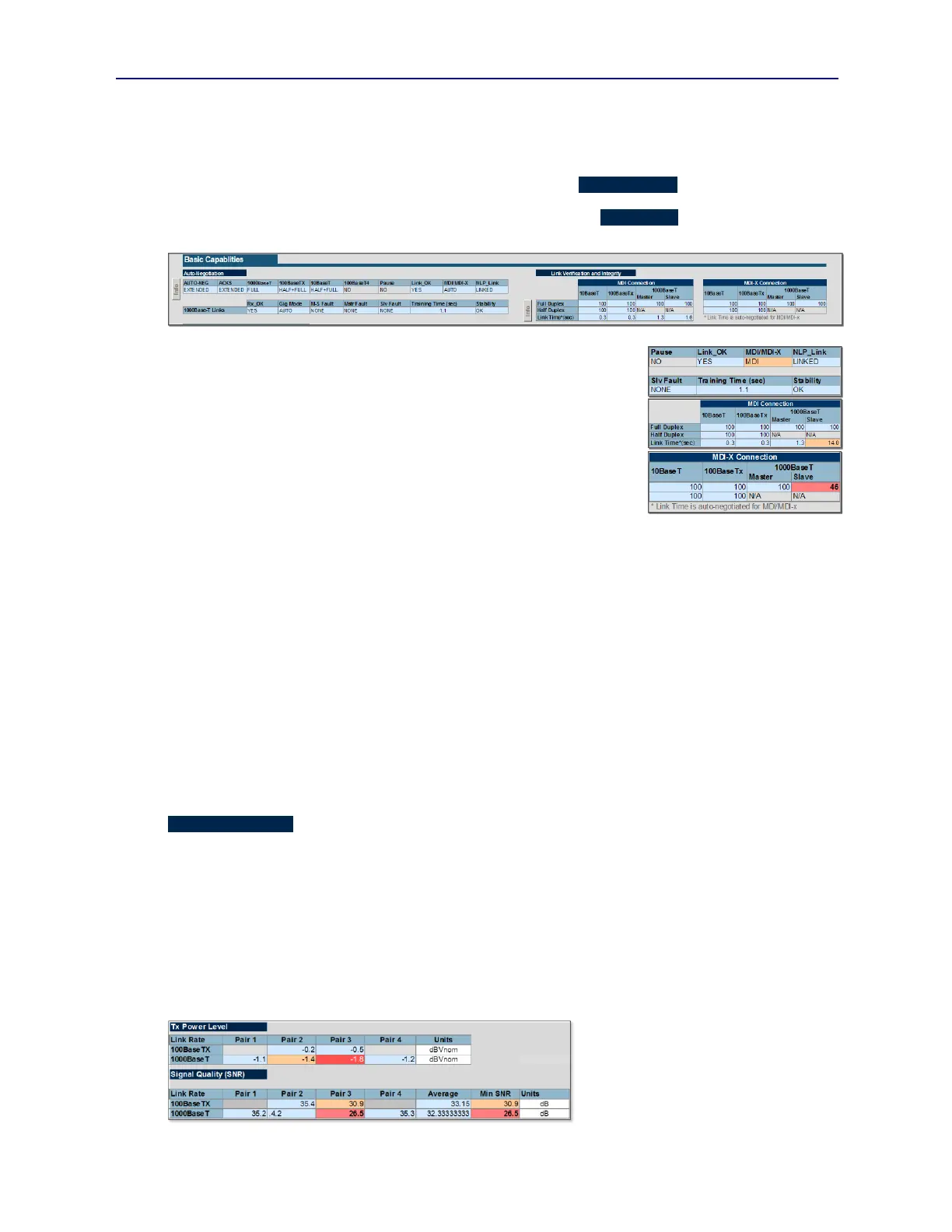PVA-3000 Reference Manual
December 2, 2019 Sifos Technologies
Wherever a given test or test condition was not performed, the related cell in the report may be blank, or may contain
the value “N/A”.
5.5.1. Basic Capabilities Test Results
The information that the Basic Capabilities test retrieves from a series of Auto-Negotiation episodes is shown in the
upper left corner of the report (see Figure 5.1). These are parameters assimilated from the auto-negotiations preceding
various link-ups. The parameters were explained earlier in Section 5.2. The Link Integrity results show the outcome of
Link Stability measurements performed with each of the established link modes and connection polarities.
Figure 5.3 provides examples of possible problem outcomes from the PVA Basic
Capabilities test. These examples include a fixed connection polarity (MDI only)
and a problem (very slow, unstable) link-up in 1000BaseT, SLAVE timing mode.
The MDI only condition will prohibit certain receiver test conditions while the
1000BaseT Slave instability may have adverse impact in both the 1000BaseT
transmission and slave-mode receiver tests. In general, severe or moderate
problems reported in Basic Capabilities are most likely related to auto-negotiation
processes that may be essential to later measurements and/or the establishment of
particular test conditions. Link-Up Timing measurements can be indirect
indicators of potential Auto-Negotiation interoperability issues.
5.5.2. Transmitter and Interface Test Results
The pva_tx_100 test reports results in each of the following reporting categories for pairs 2 and 3:
Transmit Power Level
Signal Quality (SNR)
Low Frequency PSD
Wide Band PSD
The pva_tx_1000 test reports results in each of the following reporting categories for all four pairs:
Transmit Power Level
Signal Quality (SNR)
Low Frequency PSD
Wide Band PSD
Skew, Echo, Xtalk
Transmit Power Level at both 100BaseTx and 1000BaseT is a direct result of Tx Level measurements (see Section
2.2.2). Each result (see Figure 5.4) is in dB relative to a nominal transmitter signal level defined as follows:
100BaseTx: 2.0 Vpp, 4 nsec rise/fall time, nominal magnetics
1000BaseT: 1.5 Vpp (Test Signal #1 Points A to B), Test Signal #1 Centered in Mask (~3.6 nsec
rise time), nominal magnetics
So zero dB is the ideal result. The test limits for Tx Power Level are partly based upon 802.3 tolerances for signal
amplitude, though since Transmit Power Level is a wideband measurement (see Sections 1.3.5 and 2.2.2), it also takes
into account effects of transmitter slew rate and other high frequency spectral components that may not have much
impact on peak-to-peak amplitude. Hence limits are widened to account for allowable high frequency component
variations and are assessed and tweaked from a considerable base of practical experience including formal correlation
studies.
Transmit Power Level results are also
displayed graphically as shown in Figure
5.5. This provides a quick perspective of
wideband power levels by link speed and
transmitting pair. The bar graphs will
depict both positive and negative deviations
Figure 5.4 Transmit Power Level and SNR Tabular Results
Figure 5.2 Capabilities Test Results
Figure 5.3 Capabilities Issues
